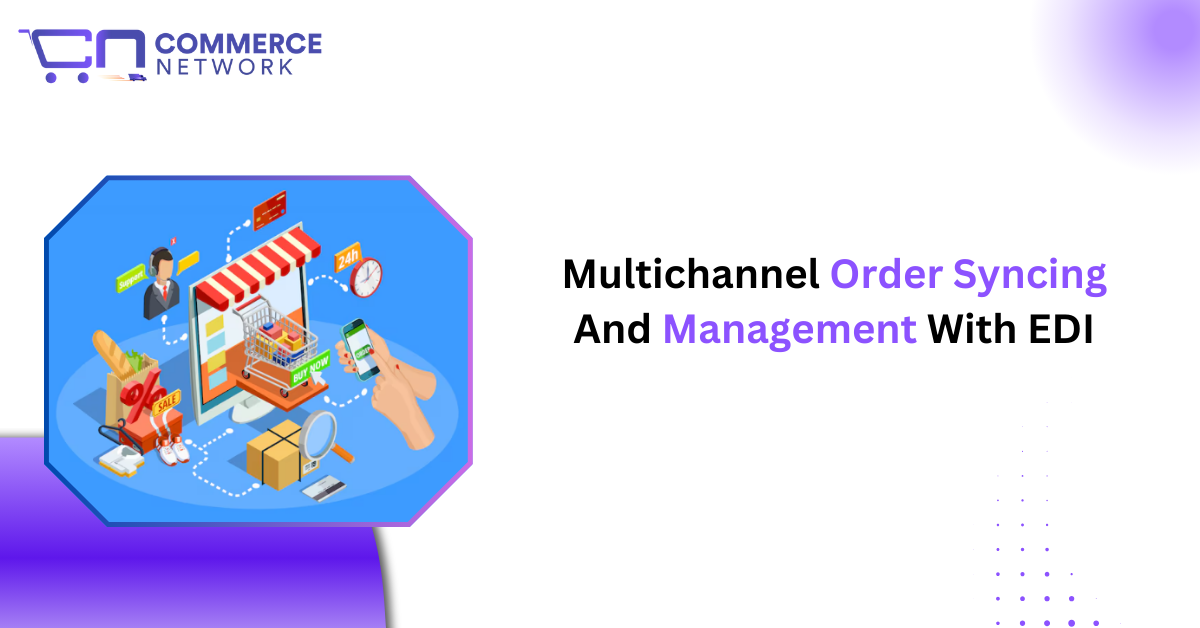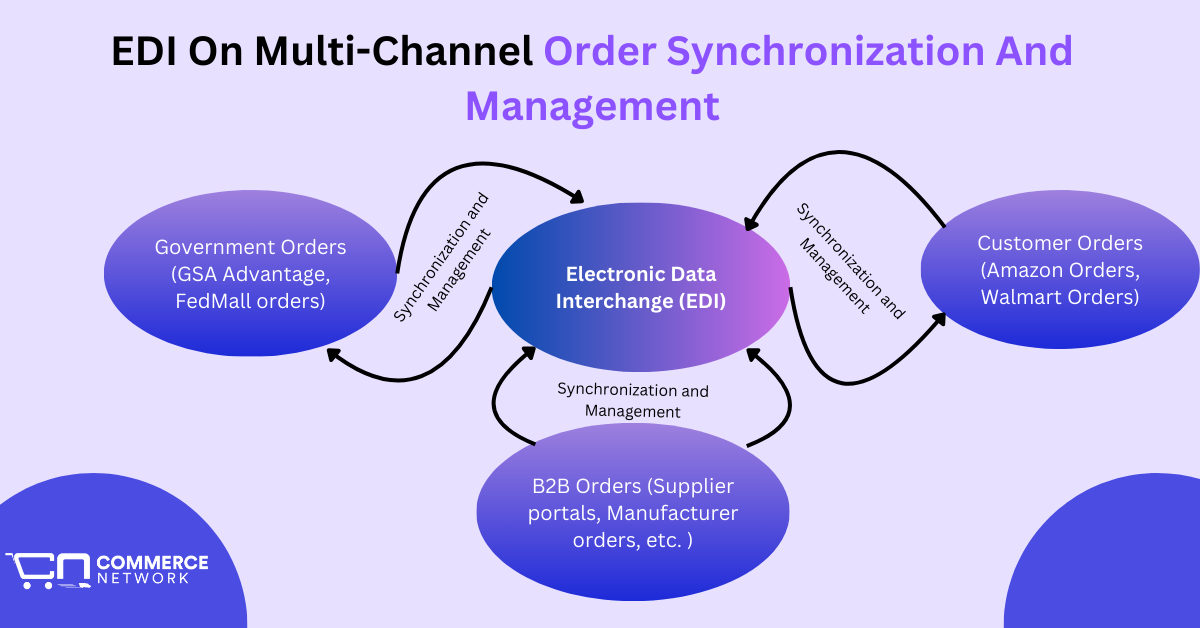
Key Takeways:
Order Synchronization: EDI unifies orders from B2B, B2C, and B2G channels in a single system.
Compliance: Helps meet government and marketplace rules to avoid penalties.
Real-Time Updates: Prevents overselling and speeds up fulfillment.
Automation: Covers the entire order-to-payment process automatically.
Hybrid Systems: Combines EDI and APIs for fast, efficient order handling.
A multichannel retailer often gets big headaches managing all their B2B, B2C, and B2G orders from within a single platform effectively and ensuring that the orders are fulfilled error-free.
Businesses must prioritize the order fulfillment process as it makes the customers happy, boosts business credibility, and helps maintain compliance in government procurement.
A multichannel retailer selling products/services across different platforms for all B2B, B2C, and B2G e-commerce, faces the problem of effective order syncing and management even more, especially due to extensive demands for compliance in B2B and B2G marketplaces.
Businesses familiar with B2B and B2G e-commerce always adopt EDI. But how is it when it comes to order syncing across multiple platforms and managing those orders?
Learn that and more in this article.
Also read: Handle High-Volume Orders With EDI In E-Commerce
A business needs to be able to see, transfer, edit, remove, compare, and more to customer orders. Now, when the customers are distributed across multiple sales channels, the orders also come from multiple channels.
Each channel has its way of handling orders (e.g. Amazon may send orders to a business different from GSA Advantage). So, a business has to see and process orders coming in from all directions and platforms efficiently to fulfill those orders.
Multichannel Order Syncing
Multichannel order syncing means making sure that orders on all of the sales channels are synced with each other. This means that if an order is placed on one channel, the whole system is updated. The update on the system affects the whole order status, tracking details, and fulfillment processes.
For example, A customer places an order on Amazon. With multichannel order syncing, the order details (status, tracking, fulfillment) are updated across your central system and connected platforms like ERP, CRM, and Accounting.
Multichannel Order Management
Multichannel order management covers the whole order fulfillment process of orders coming from different sales channels. This includes order procurement, delivery, real-time tracking and shipment, and more.
Order syncing is also a critical part of multichannel order management as the syncing process allows the business to update and customize the order process from a centralized system.
For example, a business has orders coming from Amazon, GSA Advantage, and their online storefront.
Multichannel order management handles the orders so that all the orders are fulfilled. The tasks in this process include syncing the orders from multiple channels, adjusting inventory levels to prevent over/under selling, processing shipment and delivery information of the orders, sharing the delivery routes and information to customers, notifying the business partners of order fulfillment, receiving payments, and updating the financial system based on the orders, etc.
Recommended: Integrating ERP Systems With Multi-Channel B2B And B2G E-Commerce Platforms
Electronic Data Interchange (EDI) is the structured, digital exchange of business documents such as purchase orders, invoices, and shipping notices between organizations using standardized formats (e.g., ANSI X12, EDIFACT).
Unlike emails or PDFs, EDI automates data transfer in machine-readable formats, eliminating manual entry and reducing errors.
EDI’s Role in Multichannel Order Synchronization and Management
In multichannel commerce, orders originate from disparate systems:
EDI acts as a universal translator, converting all incoming orders into a standardized format that integrates with a company’s Order Management System (OMS).
For example:
An Amazon order (via API) and a GSA Advantage order (via EDI 850) are transformed into a unified format. The OMS consolidates these orders, checks inventory in real-time, and allocates stock. The system auto-generates shipping labels and updates all channels with tracking data (EDI 856 Ship Notice).
This synchronization prevents overselling, ensures consistent fulfillment, and provides a single source of truth for orders across channels.
Also Read: EDI Compliance In B2B and B2G Environments

Each sales channel has unique requirements, but EDI bridges these gaps with tailored solutions.
B2B Orders (Through the supplier portal of a distributor)
EDI is the backbone of B2B transactions, especially in industries like retail, manufacturing, and healthcare.
Process: A retailer sends an EDI 850 (Purchase Order) to a supplier. The supplier confirms with an EDI 855 (Order Acknowledgment).
Post-fulfillment, an EDI 856 (Advance Ship Notice) and EDI 810 (Invoice) are exchanged.
Benefits: Eliminates manual processing, accelerates order cycles, and ensures compliance with trading partner rules.
B2G Orders (Order from GSA Advantage platform)
Government contracts often mandate strict EDI formats (e.g., GS1 standards for GSA Advantage).
Process: Orders arrive as EDI 850s with government-specific codes (e.g., contract numbers). Suppliers must respond with EDI 855s and include mandatory data like Cage Codes or SAM.gov details.
Benefits: Avoids penalties for non-compliance and streamlines audits.
B2C Marketplaces (Orders From Amazon, Walmart, and Shopify)
While Walmart has EDI mandates for suppliers and other businesses, platforms like Amazon or Shopify often use APIs or CSV files. Using a middleware or a tailored SAAS solution converts API/CSV data into EDI formats (or vice versa).
For example: An Amazon Seller Central order is translated into an EDI-like format for integration with legacy ERP systems.
Post-fulfillment, tracking data is pushed back to Amazon via API.
Benefits: Maintains B2C speed while aligning with B2B/B2G workflows.
Case Study: A medical supplies company uses EDI to manage orders from hospitals (B2B), the VA (Veteran Affairs) via GSA Advantage (B2G), and its Shopify store (B2C). By converting all orders into EDI 850s, their OMS (Order Management System) automatically prioritizes urgent B2G contracts while fulfilling B2C orders within SLA (Service Level Agreement) windows.
EDI automates the entire procure-to-pay (P2P) cycle, linking order fulfillment with financial reconciliation.
In a multichannel scenario with multiple orders; all with different standards, requirements, and different channels, EDI ensures the fulfillment of these orders through a standardized approach.
Here is a step-by-step guide on the procure-to-pay cycle of multichannel order fulfillment through EDI for B2B, B2G, and B2C orders.
Step 1: Order Placement
B2B: Orders arrive via EDI 850 (Purchase Order) from retailers, distributors, or procurement systems (e.g., SAP Ariba).
B2G: Government platforms like GSA Advantage require EDI 850s with contract-specific data (e.g., Cage Codes, SIN numbers).
B2C: Orders from Amazon, Shopify, or eBay typically use APIs/CSVs. Middleware converts these into EDI-like formats for integration with legacy systems.
EDI’s Role:
Example:
A B2G order from GSA Advantage and a B2C order from Amazon are both converted into EDI 850s. The system cross-checks contract compliance (B2G) and inventory availability (B2C) simultaneously.
Step 2: Inventory Allocation & Fulfillment
The Order Management System (OMS) allocates inventory based on priority (e.g., B2G orders first due to strict SLAs). Warehouse systems receive EDI 940 (Warehouse Shipping Order) to initiate picking/packing.
EDI’s Role:
Updates inventory in real-time across channels using EDI 846 (Inventory Inquiry/Advice) to prevent overselling.
Triggers fulfillment workflows:
Example:
A medical supplier prioritizes a VA hospital’s B2G order over a B2C order. EDI 856 alerts both the VA and the B2C customer about shipment timelines.
Step 3: Delivery & Proof of Delivery (POD)
Carriers share delivery updates via EDI 214 (Transportation Carrier Shipment Status) for real-time tracking. POD is captured digitally (e.g., e-signatures for B2B/B2G, email/SMS for B2C).
EDI’s Role:
Automates tracking updates to customers:
Example:
A B2G order for the Department of Defense requires an EDI 214 with military-specific codes to confirm delivery.
Step 4: Invoicing & Payment
Supplier sends EDI 810 (Invoice) post-delivery. Buyer’s system performs 3-way matching (PO vs. Ship Notice vs. Invoice) to validate charges. Payment is initiated via EDI 820 (Payment Order/Remittance Advice).
EDI’s Role:
Example:
A B2B retailer’s ERP auto-approves an EDI 810 invoice because it matches the EDI 850 (PO) and EDI 856 (shipment), triggering an EDI 820 payment.
Step 5: Reconciliation & Reporting
Financial systems reconcile payments (EDI 820) with invoices (EDI 810). EDI 867 (Sales Reporting) aggregates data across channels for performance analysis. EDI 824 (Application Advice) flags discrepancies (e.g., short payments).
EDI’s Role:
Generates unified reports for:
Example:
A manufacturer uses EDI 867 to compare the profitability of B2B (low-margin, high-volume) vs. B2C (high-margin, erratic demand) sales.
APIs are mostly used for B2C order procurement, synchronization, and management. However, a system that uses EDI also uses API for many operations, chief among them being the real-time instantaneous data transmission.
An order from a commercial marketplace like Amazon usually comes in the form of an API order. That is not to say that EDI is not used by these platforms. Amazon and Walmart have extensive EDI operations and compliance requirements for suppliers trying to sell their goods through the marketplaces.
However, many cases involving customer demands, real-time replies to messages, instant payment procession, etc. require the use of APIs.
In the case of multichannel order syncing and management, APIs can be a powerful tool for making sure that all the orders coming from the B2C marketplaces are given the same priority as the orders from the B2B and B2G platforms.
Additionally, APIs can work together with EDI to form a hybrid solution that can give businesses the edge required in terms of faster order processing, real-time delivery timelines, location tracking, and financial processing.
Solutions like Commerce Network offer a comprehensive EDI and E-Commerce platform that helps optimize the supply chain of businesses. This includes managing and syncing orders for fulfillment to business customers, government procurement entities, and B2C consumers.
The SAAS platform by Commerce Network can be utilized to manage orders from both commercial and government marketplaces.
Syncing and managing orders from large-scale distributors like Essendant and S.P Richards, or managing orders and catalogs from GSA Advantage and FedMall for government contractors, Commerce Network’s suite of EDI and E-commerce services helps clients manage their multichannel orders in a centralized platform.
Commerce Network also offers a cloud-based web-EDI platform from where businesses can get a complete overview of their orders and the management processes of those orders as a dashboard.
So, if you are a business trying to manage multiple B2B, B2C, and even B2G orders to increase your sales and boost profits, try giving Commerce Network a chance.
In today’s digital economy, businesses must manage B2B, B2C, and B2G orders. EDI remains the backbone of order synchronization, automating transactional data exchange. While challenges like fragmentation and compliance persist, hybrid platforms like those equipped with API-integrated services and automation can turn them into opportunities. Modernizing EDI strategies streamlines operations and drives a competitive edge.
Improve Your B2B, B2G, and B2C Ecommerce?
Integrate EDI For Efficiency, Compliance, and Scalability?
Just Curious About EDI?
Give Us A Call
202-280-7060